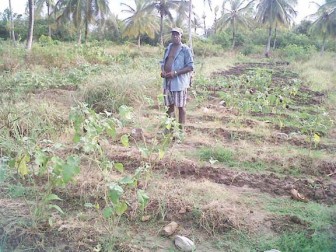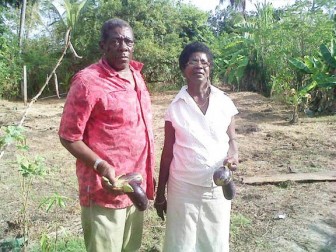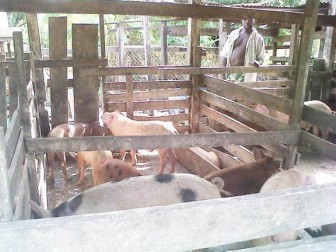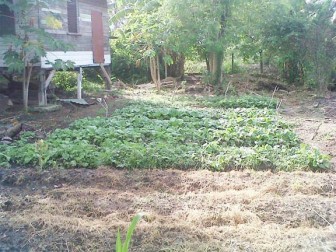Five years ago, a group of farmers plying their trade in the Central Mahaicony village of Perth responded to the encouragement of the Ministry of Agriculture to band themselves into a collective in order to benefit from support services that were already being made available to other groups of farmers across the country.
The Central Mahaicony, Perth Farmers Association, the product of that initiative, comprises more than 20 farmers and Chair-person of the Association Gloria Adams says that while transforming their respective agricultural pursuits into thriving commercial ventures has been a challenge, working together has had its advantages.
By and large, the Ministry of Agriculture has been as good as its word. Members of the association have benefited from several training programmes organised by the Guyana School of Agriculture at Mon Repos, including training in farming techniques designed to realise higher crop and livestock yield. Four prized boars, gifts from the Ministry of Agriculture, are among the association’s cherished possessions. Pressed into service for breeding purposes amongst livestock owned by members, the boars provide a modest but steady income for the association.

The ministry has also been instrumental in providing training for two youths from the community at the Guyana School of Agriculture, Mon Repos.
The support of the Ministry of Agriculture notwithstanding, it has been hard for the intrepid Mahaicony farmers. Since the association’s establishment in 2007, membership has dwindled significantly. At its inception the association numbered around 50 members.
Only 20 members remain. The chairperson says that the dwindling numbers reflect the severity of the challenges which the association has had to endure. Of the 20 members, 12 rear pigs, five cultivate cash crops, while the others rear poultry and small ruminants.

The challenges vary from one farmer to another.
Neil and Beverley Halley, who bought a 15-acre farm at Friend-ship about five years ago, rear pigs. Just recently, they have begun to cultivate food crops. They complain about the alligator population in the community and the danger which this poses to their pigs.
The Halleys are in the process of erecting new pens as part of a process of increasing their stock of pigs. The numbers are currently up to 50 and they intend to add 40 to that number. The Halleys say that pigs are a labour intensive commercial pursuit and that workers are demanding $4,000 per day to work on pig farms. The Halleys say they cannot afford to pay that. Their problems are compounded by the fact that their crops are threatened by wild animals and flooding.

Julian Jones, one of the more versatile members of the association, rears pigs, ducks and cattle and cultivates cash crops. For a while he also experimented with bacon and ham production.
A small but apparently voracious jaguar population in the Abary area poses a threat to cattle, but he perseveres.
Jones says he owes the ministry a debt of gratitude for teaching him techniques associated with ensuring that his animals are properly nourished. He has learnt to prepare a concoction of molasses, urea, salt, bran and cement, which is mixed, poured into a mould and left to harden. The moulds are placed on the farm and left for the animals to lick from time to time. They are, he says, an excellent food supplement.

Edward Rodrigues has been a farmer and member of the association since being bitten by a snake while working as a miner in the interior. His farm is situated at Perth. His primary problem is access to water. When Stabroek Business visited his farm last Sunday he was in high spirits having only just been “blessed” with a brisk shower of rain. His alternative source of water is about half an hour away and in the absence of rain he must make three to four trips daily using a bicycle and a five-gallon container if his crops are to be watered. Much of what he cultivates eventually “goes under” for lack of water. He points out too that a faulty koker door means that the crops are often vulnerable to salt water. He believes that improved drainage and irrigation will significantly improve his agricultural yield.
He sells his crops at the Mahaicony Market, some to vendors and some to housewives. He has only just begun to reap pepper, the seeds for which were given to him by the Agriculture Ministry.
Members of the association have also been beneficiaries of training, grants and loans from the Rural Enterprise and Agricultural Project (READ) a United Nations International Fund for Agricultural Development (IFAD) project that seeks to enhance the circumstances of resource-poor households, especially small-scale producers and vulnerable groups. The READ project seeks to increase market opportunities for small rural producers to improve both their productive capacity and their marketing skills.
Up until 2008, Gloria Adams had been a poultry farmer for more than 15 years. With the advent of the READ project she switched to pigs and layers. The decision to make the change was “quite simple”, pig rearing is “less of challenge and the money is good”. The pigs are sold as “live carcasses”, that is, the overall weight is estimated, excluding the weight of the guts. Apart from that the mortality rate is much less. There are other considerations, she says, including fluctuating prices in the case of chicken and concerns over the quality of feed.
Like many of the country’s small and medium-sized farmers and agro processors marketing of produce is the biggest challenge facing the association. Some of the pig rearers have informal business relationships with butchers at the Mahaicony, Mon Repos, Canal Number One and Vreed-en-Hoop markets. These arrangements allow for butchers to call on the farmers at Mahaicony to inspect pigs and make purchases.
For the bigger cash crop farmers, the challenge is greater. Each week, they venture into the increasingly competitive commercial spaces comprising the city’s main municipal markets where they market their greens and vegetables.
Here there are no reliable price guarantees. Adams says that two years ago, the association secured a contract to supply 2,000 pounds of pork weekly. After the order was increased to 1,000 pounds daily, the association lost the contract in view of its inability to supply.
Those members who sell ducks do decidedly better. There is always a ready market for ducks and the price never goes below $300 per pound for live birds and $1,000 per pound for plucked birds.
Amidst the various challenges that confront them both as individual business enterprises and as a collective the members of the association persevere.
Adams says that while the challenges are many and varied, the absence of steady and reliable markets is probably the biggest collective challenge. The association, she says, is not amenable to entering into arrangements with small groups of urban middlemen and consumers who may well be able to earn additional money from finding markets for some of the produce cultivated and reared by the association’s members.





